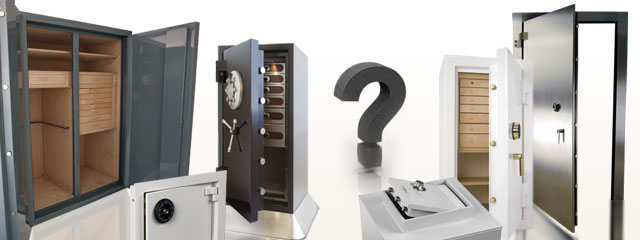
So just what kind of safe should I be looking for? What and who should it protect me from? What items should I be protecting? Where should I put the safe? How do I know the safe will do it's job?
If you're seeking advice to these and other common safe questions, look no further. This guide is filled with qualified answers to general safe questions and will even provide useful tips for the more studied safe aficionado.
This guide offers solid advice when buying a safe from any manufacturer, not just our own.
Here's the steps we suggest when deciding which safe is right for you...
1. Decide on a safe type - Our "Safe types Quick Reference" page is a very handy aid in quickly defining the primary differences in all popular safe styles. It's the perfect guide when initially deciding which type of safe is right for you.
Need more help deciding on the best safe type, try out our valuable Safe Selection Helper.
2. Learn the lingo - The information in this guide is aimed at quickly distilling commonly confusing safe terminology into easily digestible terms and concepts that aid you the buyer in understanding a safes true capabilities or deficiencies. Simply read through the information provided in these pages to rapidly build your understanding.
For a very handy list of common safe terms and their plain english definitions, click here.
3. Make a list of requirements - Once you understand the common safe terms and you've read through the pertinent information for your chosen safe type, you should have enough info to start your personalized list of safe requirements. To add definitive values to your requirements list, you can follow links within this guide to our own safe information pages where cold hard facts and figures are always available.
Be sure to take a look at the Protection Levels page as it identifies the key requirements to look for in any well built safe.
Our Safe Buying Tips page is a great resource, providing highly helpful purchase suggestions for all safe types.
4. Compare safe builders based on your requirement list - We know we build the best, but you don't ...yet. So don't just rely on our word, compare your list of requirements to other safe builders. In this way you can appreciate the true superiority of a Brown Safe along with having the pride and security that comes from knowing your cherished valuables are fully secured by the toughest safe on the block.
Unfortunately, researching the competition can also prove to be one of the more time intensive steps in this process as many safe builders don't readily provide the core safe information that reveals a safes true ability to protect, often using their own brand of confusing information deficient terminology to severely distract from the true protection rating their safe offers.
Our Competitor Comparison page is a great timesaver as it provides a direct comparison of the most important safe figures from a wide selection of top selling manufacturers.
Despite the hoopla of high protection features a safe company claims to have, any safe worth consideration must have at least 1/4" solid steel body and 1/2" solid steel door or better. If you settle for a safe with a steel thickness any less, you are exposing all valuables you store within, to SERIOUS risk of theft.
5. Make an informed decision - At this point you are no longer one of the countless uninformed victims that unscrupulous safe builders rely on to generate a quick buck at great personal risk to the buyer. You are now armed with enough knowledge to make an informed purchase about one of the most important assets you will own. Kudos to you.